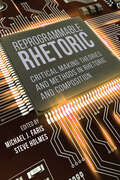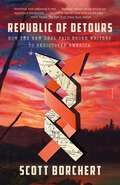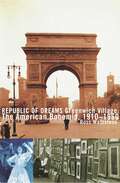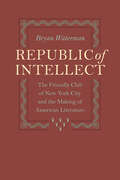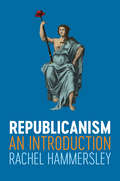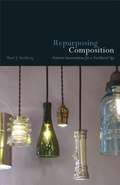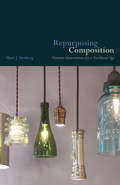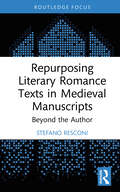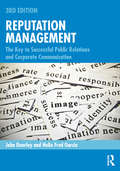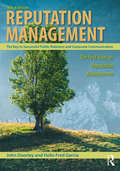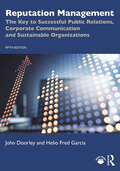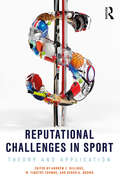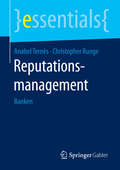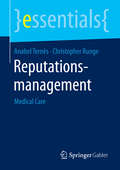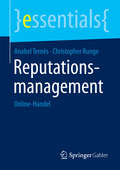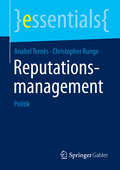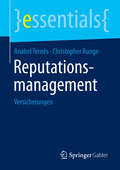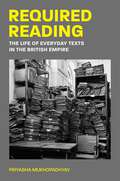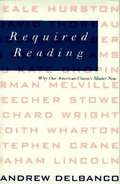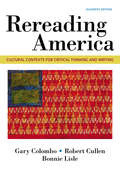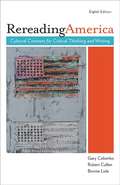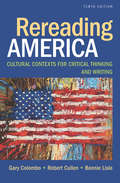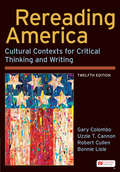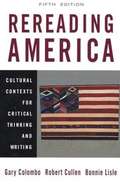- Table View
- List View
Reprogrammable Rhetoric: Critical Making Theories and Methods in Rhetoric and Composition
by Steve Holmes Michael J. FarisReprogrammable Rhetoric offers new inroads for rhetoric and composition scholars’ past and present engagements with critical making. Moving beyond arguments of inclusion and justifications for scholarly legitimacy and past historicizations of the “material turn” in the field, this volume explores what these practices look like with both a theoretical and hands-on “how-to” approach. Chapters function not only as critical illustrations or arguments for the use of reprogrammable circuits but also as pedagogical instructions that enable readers to easily use or modify these compositions for their own ends. This collection offers nuanced theoretical perspectives on material and cultural rhetorics alongside practical tutorials for students, researchers, and teachers to explore critical making across traditional areas such as wearable sensors, Arduinos, Twitter bots, multimodal pedagogy, Raspberry Pis, and paper circuitry, as well as underexplored areas like play, gaming, text mining, bots, and electronic monuments. Designed to be taught in upper division undergraduate and graduate classrooms, these tutorials will benefit non-expert and expert critical makers alike. All contributed codes and scripts are also available on Utah State University Press’s companion website to encourage downloading, cloning, and repurposing. Contributors: Aaron Beveridge, Kendall Gerdes, Kellie Gray, Matthew Halm, Steven Hammer, Cana Uluak Itchuaqiyaq, John Jones, M.Bawar Khan, Bree McGregor, Sean Morey, Ryan Omizo, Andrew Pilsch, David Rieder, David Sheridan, Wendi Sierra, Nicholas Van Horn
Republic of Detours: How the New Deal Paid Broke Writers to Rediscover America
by Scott BorchertA New York Times Book Review Editors' ChoiceAn immersive account of the New Deal project that created state-by-state guidebooks to America, in the midst of the Great Depression—and employed some of the biggest names in American lettersThe plan was as idealistic as it was audacious—and utterly unprecedented. Take thousands of hard-up writers and put them to work charting a country on the brink of social and economic collapse, with the aim of producing a series of guidebooks to the then forty-eight states—along with hundreds of other publications dedicated to cities, regions, and towns—while also gathering reams of folklore, narratives of formerly enslaved people, and even recipes, all of varying quality, each revealing distinct sensibilities. All this was the singular purview of the Federal Writers’ Project, a division of the Works Progress Administration founded in 1935 to employ jobless writers, from once-bestselling novelists and acclaimed poets to the more dubiously qualified. The FWP took up the lofty goal of rediscovering America in words and soon found itself embroiled in the day’s most heated arguments regarding radical politics, racial inclusion, and the purpose of writing—forcing it to reckon with the promises and failures of both the New Deal and the American experiment itself. Scott Borchert’s Republic of Detours tells the story of this raucous and remarkable undertaking by delving into the experiences of key figures and tracing the FWP from its optimistic early days to its dismemberment by the House Committee on Un-American Activities. We observe notable writers at their day jobs, including Nelson Algren, broke and smarting from the failure of his first novel; Zora Neale Hurston, the most widely published Black woman in the country; and Richard Wright, who arrived in the FWP’s chaotic New York City office on an upward career trajectory courtesy of the WPA. Meanwhile, Ralph Ellison, Studs Terkel, John Cheever, and other future literary stars found encouragement and security on the FWP payroll. By way of these and other stories, Borchert illuminates an essentially noble enterprise that sought to create a broad and inclusive self-portrait of America at a time when the nation’s very identity and future were thrown into question. As the United States enters a new era of economic distress, political strife, and culture-industry turmoil, this book’s lessons are urgent and strong.
Republic of Dreams: Greenwich Village: The American Bohemia, 1910-1960
by Ross WetzsteonIf the twentieth century was the American century, it can be argued that it was more specifically the New York century, and Greenwich Village was the incubator of every important writer, artist, and political movement of the period. From the century's first decade through the era of beatniks and modern art in the 1950s and '60s, Greenwich Village was the destination for rebellious men and women who flocked there from all over the country to fulfill their artistic, political, and personal dreams. It has been called the most significant square mile in American cultural history, for it holds the story of the rise and fall of American socialism, women's suffrage, and the commercialization of the avant-garde. One Villager went so far as to say that "everything started in the Village except Prohibition," and in the 1940s, the young actress Lucille Ball said, "The Village is the greatest place in the world." What other community could claim a spectrum ranging from Henry James to Marlon Brando, from Marcel Duchamp to Bob Dylan, from Gertrude Vanderbilt Whitney to Abbie Hoffman? The story of the Village is, in large part, the stories old Villagers have told new Villagers about former Villagers, and to tell its story is in large part to tell its legends. Republic of Dreams presents the remarkable, outrageous, often interrelated biographies of the giants of American journalism, poetry, drama, radical politics, and art who flocked to the Village for nearly half a century, among them Eugene O'Neill, whose plays were first produced by the Provincetown Players on Macdougal Street, for whom Edna St. Vincent Millay also wrote; Jackson Pollock, who moved to the Village from Wyoming in 1930 and was soon part of the group of 8th Street painters who would revolutionize Western painting; E. E. Cummings, who lived for years on Patchin Place, as did Djuna Barnes; Max Eastman, who edited the groundbreaking literary and political journal The Masses, which introduced Freud to the American public and also published Sherwood Anderson, Amy Lowell, Upton Sinclair, Maksim Gorky, and John Reed's reporting on the Russian Revolution. Republic of Dreams is beautifully researched, outspoken, wise, hip, exuberant, a monumental, definitive history that will endure for decades to come.
Republic of Intellect: The Friendly Club of New York City and the Making of American Literature (New Studies in American Intellectual and Cultural History)
by Bryan WatermanIn the 1790s, a single conversational circle—the Friendly Club—united New York City's most ambitious young writers, and in Republic of Intellect, Bryan Waterman uses an innovative blend of literary criticism and historical narrative to re-create the club's intellectual culture. The story of the Friendly Club reveals the mutually informing conditions of authorship, literary association, print culture, and production of knowledge in a specific time and place—the tumultuous, tenuous world of post-revolutionary New York City. More than any similar group in the early American republic, the Friendly Club occupied a crossroads—geographical, professional, and otherwise—of American literary and intellectual culture. Waterman argues that the relationships among club members' novels, plays, poetry, diaries, legal writing, and medical essays lead to important first examples of a distinctively American literature and also illuminate the local, national, and transatlantic circuits of influence and information that club members called "the republic of intellect." He addresses topics ranging from political conspiracy in the gothic novels of Charles Brockden Brown to the opening of William Dunlap's Park Theatre, from early American debates on gendered conversation to the publication of the first American medical journal. Voluntary association and print culture helped these young New Yorkers, Waterman concludes, to produce a broader and more diverse post-revolutionary public sphere than scholars have yet recognized.
Republicanism, Rhetoric, and Roman Political Thought
by Daniel J. KapustRepublicanism, Rhetoric, and Roman Political Thought develops readings of Rome's three most important Latin historians – Sallust, Livy and Tacitus – in light of contemporary discussions of republicanism and rhetoric. Drawing on recent scholarship as well as other classical writers and later political thinkers, this book develops interpretations of the three historians' writings centering on their treatments of liberty, rhetoric, and social and political conflict. Sallust is interpreted as an antagonistic republican, for whom elite conflict serves as an outlet and channel for the antagonisms of political life. Livy is interpreted as a consensualist republican, for whom character and its observation helps to maintain the body politic. Tacitus is interpreted as being centrally concerned with the development of prudence and as a subtle critic of imperial rule.
Republicanism: An Introduction
by Rachel HammersleyRepublicanism is a centuries-old political tradition, yet its precise meaning has long been contested. The term has been used to refer to government in the public interest, to regimes administered by a collective body or an elected president, and even just to systems embodying the values of liberty and civic virtue. But what do we really mean when we talk about republicanism? In this new book, leading scholar Rachel Hammersley expertly and accessibly introduces this complex but important topic. Beginning in the ancient world, she traces the history of republican government in theory and practice across the centuries in Europe and North America, concluding with an analysis of republicanism in our contemporary politics. She argues that republicanism is a dynamic political language, with each new generation of thinkers building on the ideas of their predecessors and adapting them in response to their own circumstances, concerns, and crises. This compelling account of the origins, history, and potential future of one of the world’s most enduring political ideas will be essential reading for anyone with an interest in republicanism, from historians and political theorists to politicians and ordinary citizens.
Repurposing Composition: Feminist Interventions for a Neoliberal Age
by Shari J StenbergIn Repurposing Composition, Shari J. Stenberg responds to the increasing neoliberal discourse of academe through the feminist practice of repurposing. In doing so, she demonstrates how tactics informed by feminist praxis can repurpose current writing pedagogy, assessment, public engagement, and other dimensions of writing education. Stenberg disrupts entrenched neoliberalism by looking to feminism's long history of repurposing "neutral" practices and approaches to the rhetorical tradition, the composing process, and pedagogy. She illuminates practices of repurposing in classroom moments, student writing, and assessment work, and she offers examples of institutions, programs, and individuals that demonstrate a responsibility approach to teaching and learning as an alternative to top-down accountability logic. Repurposing Composition is a call for purposes of work in composition and rhetoric that challenge neoliberal aims to emphasize instead a public-good model that values difference, inclusion, and collaboration.
Repurposing Composition: Feminist Interventions for a Neoliberal Age
by Shari J. StenbergIn Repurposing Composition, Shari J. Stenberg responds to the increasing neoliberal discourse of academe through the feminist practice of repurposing. In doing so, she demonstrates how tactics informed by feminist praxis can repurpose current writing pedagogy, assessment, public engagement, and other dimensions of writing education. Stenberg disrupts entrenched neoliberalism by looking to feminism’s long history of repurposing “neutral” practices and approaches to the rhetorical tradition, the composing process, and pedagogy. She illuminates practices of repurposing in classroom moments, student writing, and assessment work, and she offers examples of institutions, programs, and individuals that demonstrate a responsibility approach to teaching and learning as an alternative to top-down accountability logic. Repurposing Composition is a call for purposes of work in composition and rhetoric that challenge neoliberal aims to emphasize instead a public-good model that values difference, inclusion, and collaboration.
Repurposing Literary Romance Texts in Medieval Manuscripts: Beyond the Author (Young Feltrinelli Prize in the Moral Sciences)
by Stefano ResconiTranscribing a text within a Medieval manuscript was often not a culturally and ideologically neutral act. The lack of direct control by the authors over the circulation of their works allowed scribes to employ particularly refined strategies aimed at assigning new functions and meanings to these texts, which might appear very different from the original to the readers. This could be achieved in various ways, such as manipulating the configuration of the manuscript, creating or emphasising textual connections within organised collections, exploiting paratexts, or making more significant alterations to the text itself.This volume provides an overview of the primary ways in which textual repurposing and the consequent guiding of the reader are achieved within the manuscript tradition of Medieval Romance literary texts. Each method is described and exemplified through detailed analysis of particularly significant cases, which not only offer interesting insights into the perception of authorship in this literary context but also reveal unexpected ways through which manuscript compilers revitalise and enhance the communication of the works they handle.This book will be of interest to readers of Romance Medieval literature, Medieval manuscript culture, and material philology.
Reputation Management: The Key to Successful Public Relations and Corporate Communication
by John Doorley Helio Fred GarciaReputation Management is a how-to guide for students and professionals, as well as CEOs and other business leaders. It rests on the premise that reputation can be measured, monitored, and managed. Organized by corporate communication units including media relations, employee communication, government relations, and investor relations, the book provides a field-tested guide to corporate reputation problems such as leaked memos, unfair treatment by the press, and negative rumors, and focuses on practical solutions. Each chapter is fleshed out with the real-world experience of the authors and contributors, who come from a wide range of professional corporate communication backgrounds. Updates to the third edition include: Global content has been incorporated and expanded throughout the book, rather than being restricted to only one chapter. Opening vignettes, examples, and case studies have been updated in each chapter. Additional case studies and examples with an international focus have been added.
Reputation Management: The Key to Successful Public Relations and Corporate Communication
by John Doorley Helio Fred GarciaReputation Management is an established how-to guide for students and professionals, as well as CEOs and other business leaders. This fourth edition is updated throughout, including: new social media management techniques for the evolving age of digital media, and perspectives on reputation management in an era of globalization. The book is embroidered by ethics, and organized by corporate communication units, such as media relations, issues management, crisis communication, organizational communication, government relations, and investor relations. Each chapter is fleshed out with the real-world experiences cited by the authors and contributions from 36 leaders in the field, including The Arthur W. Page Society, the International Communications Consultancy Organization, the PR Council, CVS Health, Edelman and Ketchum. This was the first book on reputation management and, now in its fourth edition, remains a must-have reference for students taking classes in public relations management, corporate communication, communication management, and business. CEOs, business leaders, and professionals working in these areas find it a reliable resource for measuring, monitoring and managing reputation.
Reputation Management: The Key to Successful Public Relations, Corporate Communication and Sustainable Organizations
by John Doorley Helio Fred GarciaThe fifth edition of this classic text, which was the first on the subject of reputation management, gives readers the guidance and skills needed to manage brand and reputation through effective performance, behavior, identity and communication strategies.This edition is updated throughout, including current information on digital media, new global examples and a renewed emphasis on organizational and environmental sustainability. Each chapter again features timely and illustrative cases by the authors and contributions from leaders in the field, with new cases in this edition on such topics as COVID-19, artificial intelligence, and generative AI. Additionally, the book maintains its consistent throughline focusing on corporate ethics.This fifth edition is a must-have reference for students taking classes in public relations management, corporate communication, communication management and business. CEOs, business leaders and professionals working in these areas find it a reliable resource for measuring, monitoring and managing reputation.Online resources also accompany the text. Please visit www.routledge.com/9781032577999.
Reputational Challenges in Sport: Theory and Application
by Andrew C. Billings Timothy Coombs Kenon A. BrownIssues of reputation management are negotiated in a wide array of contexts, yet arguably one of the most visible of these areas involves how such stories unfold within the sporting arena. Whether involving individual athletes, teams, organizations, leagues, or global entities, the process of navigating issues of image repair and/or restoration and crisis-based communication has never been more byzantine with a plethora of communicative media outlets functioning in myriad manners. Reputational Challenges in Sport explores the intersection of reputation, sport, and society. In doing so, the book advances theory and then explores individual, team, and organizational applications from varied methodological perspectives as they relate to reputation and identity management and crisis orientations. The book provides a synthesis of previous works while offering a contemporary advancement of these subjects from a variety of epistemological approaches. It gives voice to variety of perspectives that offer a robust advancement of issues relating to reputation, sport, and modern society.
Reputationsmanagement: Banken (essentials)
by Anabel Ternès Christopher RungeAnabel Ternès und Christopher Runge zeigen am Beispiel Banken, dass es sich auszahlt, in eine hohe Reputation zu investieren. Unternehmen mit einem guten Ansehen können höhere Preise verlangen, Kunden gewinnen und binden, die besten Mitarbeiter für sich gewinnen und insbesondere in Krisenzeiten von ihrer Reputation als immateriellem Wert als Wettbewerbsvorteil zehren. Voraussetzung hierfür ist ein systematisches, professionell begleitetes Reputationsmanagement, das gewährleistet, in Zukunft zu agieren statt nur zu reagieren. Gutes Reputationsmanagement erfordert einzelne, aufeinander abgestimmte Schritte, die sich gegenseitig perfekt ergänzen – zum Aufbau, zum Erhalt und zur Verbesserung einer positiven Unternehmensreputation.
Reputationsmanagement: Medical Care (essentials)
by Anabel Ternès Christopher RungeAnabel Ternès und Christopher Runge zeigen am Beispiel Banken, dass es sich auszahlt, in eine hohe Reputation zu investieren. Unternehmen mit einem guten Ansehen können höhere Preise verlangen, Kunden gewinnen und binden, die besten Mitarbeiter für sich gewinnen und insbesondere in Krisenzeiten von ihrer Reputation als immateriellem Wert als Wettbewerbsvorteil zehren. Voraussetzung hierfür ist ein systematisches, professionell begleitetes Reputationsmanagement, das gewährleistet, in Zukunft zu agieren statt nur zu reagieren. Gutes Reputationsmanagement erfordert einzelne, aufeinander abgestimmte Schritte, die sich gegenseitig perfekt ergänzen - zum Aufbau, zum Erhalt und zur Verbesserung einer positiven Unternehmensreputation.
Reputationsmanagement: Online-Handel (essentials)
by Anabel Ternès Christopher RungeAnabel Ternès und Christopher Runge zeigen am Beispiel des Online-Handels, dass es sich auszahlt, in eine hohe Reputation zu investieren. Räumliche Grenzen existieren in Zeiten von Social Media nicht mehr. Binnen Sekunden verbreiten sich schlechte Nachrichten und Bewertungen über soziale Netzwerke und Internetforen – ob sie nun der Wahrheit entsprechen oder nicht. Eine negative Information entwickelt auf diese Weise schnell ein unkontrollierbares Eigenleben – mit unabsehbaren Folgen. Gerade im Online-Handel ist es wichtig, stets den Überblick zu behalten, was „das Netz“ über das eigene Unternehmen sagt. Negative Kundenbewertungen und schlechte Presse können zu Umsatzeinbußen führen und den Ruf nachhaltig schädigen. Wichtig ist daher, proaktiv vorzubauen, um den guten Ruf im Netz zu schützen – mit einem professionellen Partner an der Seite, der strategisch vorausplant.
Reputationsmanagement: Politik (essentials)
by Anabel Ternès Christopher RungeAnabel Ternès und Christopher Runge zeigen am Beispiel Politik, dass es sich auszahlt, in eine hohe Reputation zu investieren. Gerade wer ein politisches Amt bekleidet, steht besonders im Fokus der öffentlichen Aufmerksamkeit. Jede Geste, jedes Wort kann von sozialen Netzwerken und Online-Medien aufgegriffen und in Windeseile verbreitet werden. Klassische Medien wie Tageszeitungen, Magazine und auch TV-Sendungen verbreiten die Nachricht zusätzlich weiter, und im Nu ist ein Skandal entstanden, dessen Folgen unabsehbar sind und oftmals das Ende der Karriere bedeuten. Wichtig ist daher, proaktiv vorzubauen, um den guten Ruf im Netz zu schützen – mit einem professionellen Partner an der Seite.
Reputationsmanagement: Versicherungen (essentials)
by Anabel Ternès Christopher RungeAnabel Ternès und Christopher Runge zeigen am Beispiel Versicherungen, dass es sich auszahlt, in eine hohe Reputation zu investieren. Unternehmen mit einem guten Ansehen können höhere Preise verlangen, Kunden gewinnen und binden, die besten Mitarbeiter für sich gewinnen und insbesondere in Krisenzeiten von ihrer Reputation als immateriellem Wert als Wettbewerbsvorteil zehren. Voraussetzung hierfür ist ein systematisches, professionell begleitetes Reputationsmanagement, das gewährleistet, in Zukunft zu agieren statt nur zu reagieren. Gutes Reputationsmanagement erfordert einzelne, aufeinander abgestimmte Schritte, die sich gegenseitig perfekt ergänzen – zum Aufbau, zum Erhalt und zur Verbesserung einer positiven Unternehmensreputation.
Required Reading: The Life of Everyday Texts in the British Empire
by Priyasha MukhopadhyayHow ordinary forms of writing—including manuals, petitions, almanacs, and magazines—shaped the way colonial subjects understood their place in empire In Required Reading, Priyasha Mukhopadhyay offers a new and provocative history of reading that centers archives of everyday writing from the British empire. Mukhopadhyay rummages in the drawers of bureaucratic offices and the cupboards of publishers in search of how historical readers in colonial South Asia responded to texts ranging from licenses to manuals, how they made sense of them, and what this can tell us about their experiences living in the shadow of a vast imperial power. Taking these engagements seriously, she argues, is the first step to challenging conventional notions of what it means to read.Mukhopadhyay&’s account is populated by a cast of characters that spans the ranks of colonial society, from bored soldiers to frustrated bureaucrats. These readers formed close, even intimate relationships with everyday texts. She presents four case studies: a soldier&’s manual, a cache of bureaucratic documents, a collection of astrological almanacs, and a women&’s literary magazine. Tracking moments in which readers refused to read, were unable to read, and read in part, she uncovers the dizzying array of material, textual, and aural practices these texts elicited. Even selectively read almanacs and impenetrable account books, she finds, were springboards for personal, world-shaping readerly relationships.Untethered from the constraints of conventional literacy, Required Reading reimagines how texts work in the world and how we understand the very idea of reading.
Required Reading: Why Our American Classics Matter Now
by Andrew DelbancoDelbanco relishes language and teaching. He draws from a deep well of knowledge as he analyzes the work of 11 American authors and ends with an essay on reading for pleasure. He explains how a writer's work reflects his or her experience, efforts to create through language, and personal philosophy and position on the issues of the time. He gives us samples of how Melville attempted to convey pleasure through words with an erotic intensity. He tells us that Steven Crane lived a short, wild, life haunted by the fear that nothing he could write would ever be better than or as good as, "The Red Badge of Courage. He imagines Edith Wharton would be dismayed by another writer's completion of and subsequent publication of one of her unfinished manuscripts. Sympathetically he describes the life of Zora Hurston who collected tales of African Americans during the 1930s told in their antiquated southern dialect. Hurston was at first adored, then died discredited and in poverty, and then her work gained approval again. Dreiser derived the inspiration for some of his female characters from his sisters' experiences. Lincoln's strength of character and conviction are stirringly illustrated but Delbanco sadly concludes that the opportunities Lincoln strove to protect for all Americans are now unattainable so the Lincoln who has inspired the nation for 150 years will fade in importance. This is a volume that will inform the reader about literature and American History. It can be read for pleasure or used as a reference. The complete index is included.
Rereading America: Cultural Contexts For Critical Thinking And Writing
by Robert Cullen Gary Colombo Bonnie LisleRereading America remains the most widely adopted book of its kind because it works: instructors tell us time and again that they've watched their students grow as critical thinkers and writers as they grapple with cross-curricular readings that not only engage them, but also challenge them to reexamine deeply held cultural assumptions, such as viewing success solely as the result of hard work. <P><P>Extensive apparatus offers students a proven framework for revisiting, revising, or defending those assumptions as students probe the myths underlying them. Rereading America has stayed at the forefront of American culture, contending with cultural myths as they persist, morph, and develop anew.
Rereading America: Cultural Contexts for Critical Thinking and Writing
by Robert Cullen Gary Colombo Bonnie LisleRereading America remains the most widely adopted book of its kind because of its unique approach to the issue of cultural diversity. Unlike other multicultural composition readers that settle for representing the plurality of American voices and cultures, Rereading America encourages students to grapple with the real differences in perspectives that arise in our complex society. Selections model writing from a wide variety of disciplines and genres, and each chapter features a selection that explores how the media sells the myth in question. With extensive editorial apparatus that puts readings from the mainstream into conversation with readings from the margins, Rereading America provokes students to explore the foundations and contradictions of our dominant cultural myths.
Rereading America: Cultural Contexts for Critical Thinking and Writing
by Robert Cullen Gary Colombo Bonnie LisleRereading America remains the most widely adopted book of its kind because it works: instructors tell us time and again that they've watched their students grow as critical thinkers and writers as they grapple with cross-curricular readings that not only engage them, but also challenge them to reexamine deeply held cultural assumptions, such as viewing success solely as the result of hard work. Extensive apparatus offers students a proven framework for revisiting, revising, or defending those assumptions as students probe the myths underlying them. Rereading America has stayed at the forefront of American culture, contending with cultural myths as they persist, morph, and develop anew. The tenth edition, developed with extensive input from users, features a refreshed collection of readings with a new chapter that introduces students to one of the most pervasive myths of our time: technological innovation fosters a more equal society. Also in response to instructors' requests for more writing instruction, there are now more questions that help students apply to their own writing the strategies used in the readings.
Rereading America: Cultural Contexts for Critical Thinking and Writing
by Robert Cullen Gary Colombo Bonnie Lisle Uzzie T. CannonExamine the assumptions of American culture with a critical lensWith Rereading America’s focus on revisiting, defending, and challenging assumptions about American culture (such as “U.S. laws provide equal protection and justice for all”), you’ll grow as a critical thinker and writer.
Rereading America: Cultural Contexts for Critical Thinking and Writing (5th edition)
by Robert Cullen Gary Colombo Bonnie LisleRereading America presents diverse political and cultural perspectives as grist for critical thinking. Many of the book's 73 selections are from groups that have been pushed to the margins of our society -- people of color, women, gays and lesbians.
